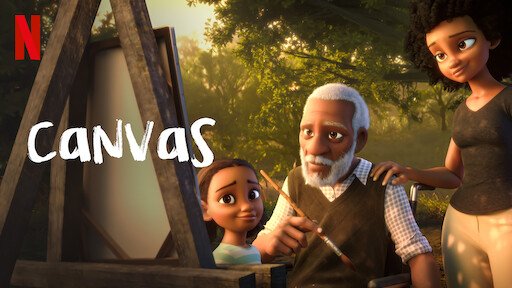A Review of Canvas
The new short film on Netflix explores the meaning of loss in a uniquely heart-warming way.

Canvas’s three characters, representing three generations of a family, come together in a time of grief.
January 3, 2021
COVID-19 has shed a harsh light upon our understanding of loss and grief. With over 300,000 Americans dead as a result of the pandemic, as well as a lessened ability to hold funerals, grieving death has become even more difficult than it once was.
Pixar animator Frank Abney debuted his Netflix short film Canvas on December 11th. The entirety of the dialogue-free film is based around a grandfather, his family, and a canvas that remained largely untouched by a paintbrush. By the end of the film, which is under 10 minutes, all of these aspects come together to reflect upon how we grieve the loss of a loved one.
The short opens with a shot of a man painting his wife, who is sitting against a tree and staring into the distance, basking in the sun and seemingly unaware of the man’s presence. While the scene establishes the purpose of the story later on, what is most impressive about this scene is the difference in animation between it and the majority of the rest of the film.
The animation of the opening scene is more fairytale-like. Miniscule in length, the opening scene is simply drawn two-dimensionally, unlike the realistic three-dimensional illustration that the viewer sees in most of the short. The viewer soon finds out that this intentional differentiation is to reveal that the man was dreaming, remembering a happy moment from his past.
This visual distinction between dreams and reality serves to show that it is common for people to view their memories, especially of loved ones, as simple and beautiful, while they can see reality only in full detail, no matter how painful it may be. The distinction is also utilized later in the film to show another happy but imagined moment.
If it was not already obvious enough by the inclusion of the man sleeping on an otherwise empty bed, an alarm that sounds similar to an electrocardiogram wakes him, crushed to learn that his dream was not reality.
The similar sounds exhibit that this was not only a dream but a memory of his deceased partner. Even things that are outwardly unimportant, such as the sound of an alarm clock, remind him of her.
It does not take long to lay the foundation for a routine. It is clear that every day is relatively the same for the old man. He rolls outside in a wheelchair, and eventually, his daughter and granddaughter drive down the street to greet him and spend a day at his house. Despite his love for his family, the days become increasingly dreary and difficult to manage for the man. The canvas that he sits in front of is blank.
The grandfather loved creating art. He even dreamed about it, as the viewer can see from the very beginning of the film. As they can also see from the opening scene’s dream, it is likely that he had attached making art to his late wife, and when she passed, he refused to paint on his canvas or draw with his granddaughter when she offered him a crayon, even though he recognizably loved her dearly.
In short, Canvas demonstrates how vital art and family can be in the process of grief.
Although there are no masks in sight, and whether or not this film was meant to take place in a world with COVID-19 is not clarified, the film shows that we are not meant to grieve alone. Without saying a word, it conveys an idea of family that is especially prevalent right now.
Spending time with loved ones helps us remember who we once were, even if it is difficult to see the past clearly when it holds the death of a family member. While the grandfather ultimately finds peace on his own, his curious and equally creative granddaughter guides him to this conclusion. His family’s presence allows him to achieve contentment in the end.
In all, the film contains characters who are full of life and emotion despite a complete lack of dialogue, making it practically impossible for the viewer to not fall in love with them and their story. The story’s relatability, especially in the trying times that we currently face, helps to pull the viewer in even further. It is a quick, heart-warming watch that is guaranteed to make you smile and reminisce.











